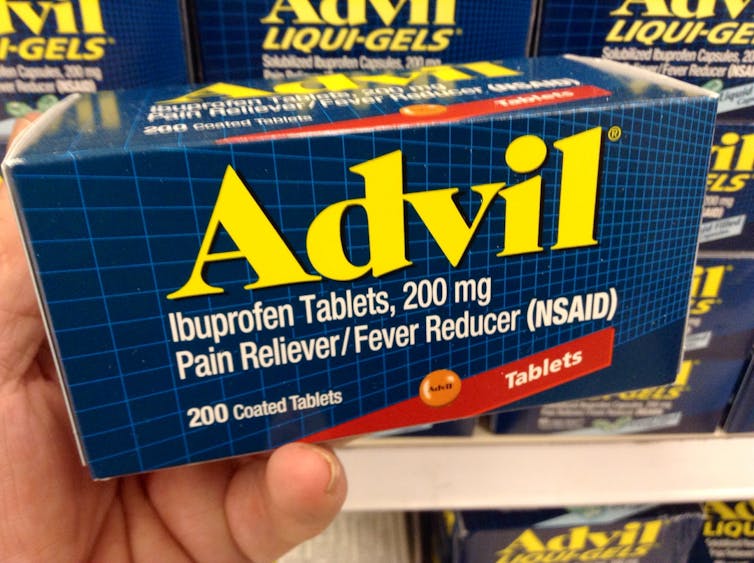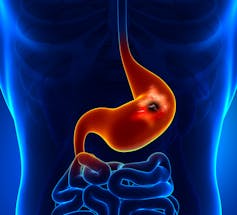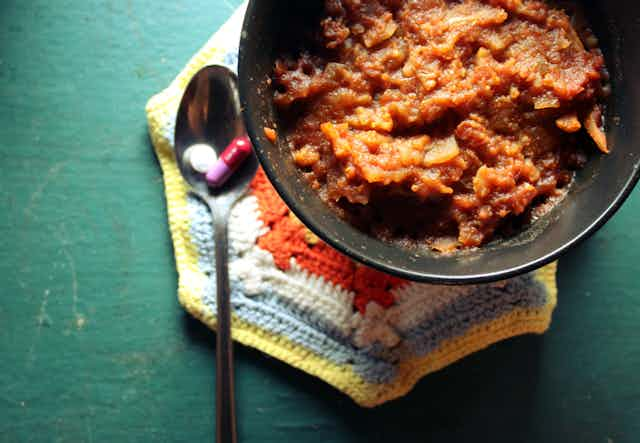Medical media recently reported that a clinicians’ reference handbook had changed advice on how to take the painkiller ibuprofen - commonly sold under the brand names Nurofen and Advil.
While the Australian Medicines Handbook previously advised this drug must be taken with food, the updated version says:
Take oral doses with a glass of water. It may be taken without food but if this upsets your stomach, try taking it with a meal.
The change isn’t particularly remarkable. Minor adjustments are often made to how we dose drugs as our knowledge improves. And yet a few medical media outlets considered it interesting enough to be a story. So why the kerfuffle?
Ibuprofen, together with drugs such as aspirin and diclofenac (Voltaren), belongs to a class of medicines called non-steroidal anti-inflammatory drugs (NSAIDs). Chronic use of these can damage the stomach lining, leading to gastritis and ulcers.
Until recently, medical advice in Australia and Europe (but not the United States) to take the painkillers with food was based on the assumption that it reduced the risk of stomach damage. Does the change in advice mean the assumption has also changed? And are we risking stomach damage when taking anti-inflamatories without food?
Gastric damage
Our stomach walls (made of protein) need protection from stomach fluid, which is highly acidic and full of enzymes dedicated to breaking down proteins in food. On an empty stomach, gastric fluid acidity ranges from that of battery acid to lemon juice.
To protect itself, the stomach secrets a layer of mucus, which can control the amount of stomach acid and neutralise it. When one or both of these mechanisms go awry, stomach lining damage and ulceration can occur.

Ironically, due to their pain-relieving properties, NSAIDs can cause serious damage to stomach lining. This is because they decrease pain and inflammation by inhibiting production of prostaglandins, a group of fatty acids that promote inflammation and increase pain perception.
But prostaglandins also protect the stomach lining from acid, by decreasing acid production and increasing mucus secretion and its neutralising properties. So inhibiting prostaglandins also reduces their protective functions.
NSAIDs are commonly used to manage the pain and inflammation of arthritis and musculoskeletal disorders. People also take them for short-term pain relief: for headaches, migraines and period pain, as well as to reduce fever. There’s an important difference between the risk to long-term users compared to someone who takes them for the occasional headache.
Gastric ulceration, where irritation to the stomach erodes its surface, can be severe. Symptoms include internal bleeding, indigestion, nausea, vomiting and weight loss. Studies show that, in relation to NSAIDs, ulceration is time- and dose-dependent.
Typical over-the-counter doses of ibuprofen are up to 1200mg per day and can be taken for up to three days. There is either no or minimal gastric damage at doses of less than 1600mg a day over three days. But people who take prescription doses for a month or more have a 2% to 4% chance of developing ulcers.
It has long been thought that food “cushions” the stomach from acidity. But, surprisingly, there is very little hard data to support that it can protect the stomach from NSAID damage.
NSAIDs with food
Food does reduce stomach acid, from around battery acid levels to somewhere around that of tomato juice or black coffee.
NSAIDs are better absorbed from acidic, rather than neutral, solutions. So an acidic stomach environment, after a night of fasting for instance, means NSAIDs will reach a higher blood concentration than after a meal. But a less acidic environment created by food will slow NSAID absorption.

In studies where animals were given high levels of NSAIDs after 24 to 48 hours of fasting, they developed ulcers in the stomach. On the other hand, animals that had been fed got ulcers in their intestine instead of their stomach. That is, ulcers developed in both circumstances - they were just found in different locations.
However, whether these effects are applicable to humans, especially with the typical doses used for pain relief, and whether different food components play a role in this shift from stomach to intestine ulceration, is unclear.
Pain relief is related to the concentrations of painkillers in the blood. There’s reasonable evidence that faster ibuprofen, or other NSAID absorption, will lead to faster pain relief.
Peak concentrations of ibuprofen in blood occur between 1.5 to three hours after a 200mg dose in people who take it with a meal. For those who take it with just water, the maximum concentration is reached after 45 minutes.
So taking ibuprofen with water is likely to result in better pain control and also reduce the need to take more. Having to take fewer doses in turn reduces the likelihood of gastrointestinal effects. Also, people who put off taking ibuprofen until they eat will suffer pain for longer than necessary.
Overall, changing from taking NSAIDs like ibuprofen with food to just water - unless there is stomach upset - may improve pain relief and is very unlikely to harm people who take the drug occasionally and as directed. Those who use ibuprofen and other NSAIDs for chronic pain relief, however, should consult their doctor about how best to take it.

